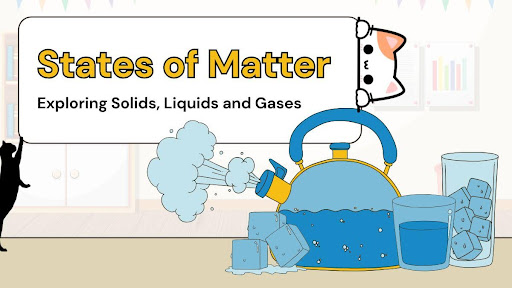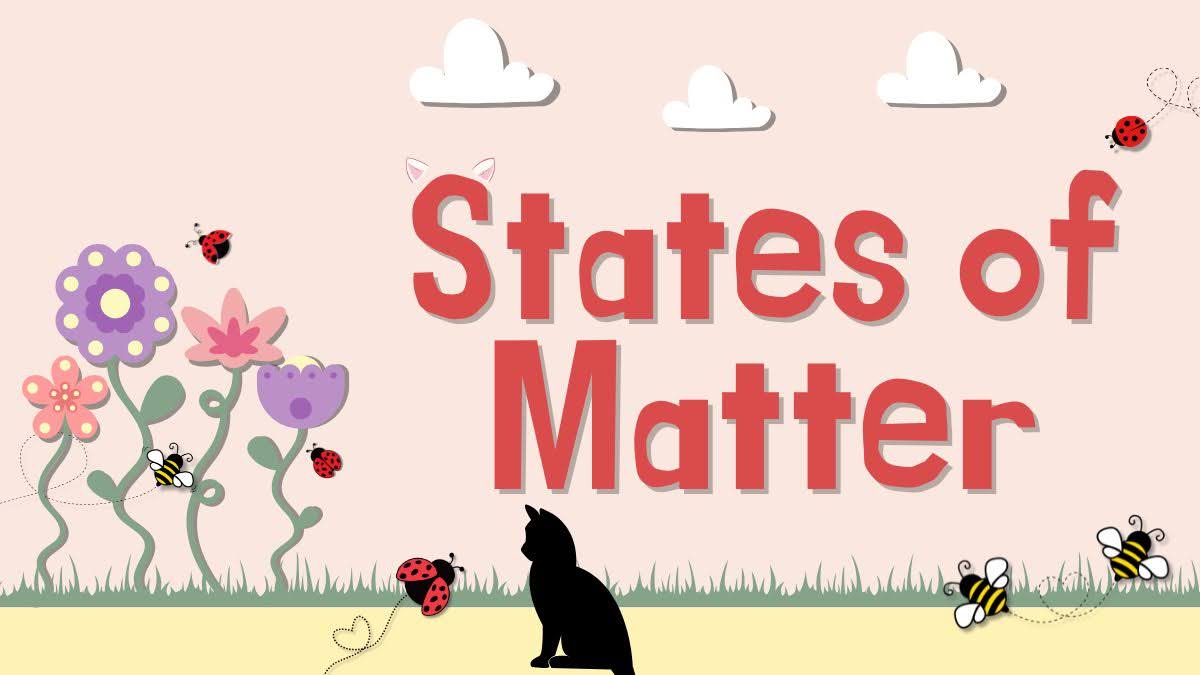solids, liquids, and gases
Blog: Exploring Solids, Liquids, and Gases – A Fun Journey Through Matter!

So the point is that everything around us is composed of matter and matter can occur in three fascinating forms i.e. solids, liquids, and gases! These are called states of matter. Well, come take your journey into these states and all the great things that they have to offer.
What Are States of Matter?

Matter exists in three main states:
-
Solids:Solid things have a fixed shape and size. Imagine a rock, a pencil, or even your favourite toy. In solids, particles crowd together and only vibrate in place.
-
Liquids: Liquids have an indefinite shape but a definite volume. They assume the shape of the container they are in. Water, milk and juice are all liquids. In liquids, the particles are somewhat farther apart than they are in solids, and they slide around one another.
-
Gases: Gases have neither a fixed shape nor volume. Either way, a gas expands across the volume that it’s been given to fill — air is a gas, as is the steam you can see wafting away from a hot cup of tea! Gases have particles that are very far apart, moving very fast.
Solids: The Strong and Steady
_20250416_144447.jpg)
Fun Fact: Did you know that ice is also a solid? When it turns to liquid, it is called water!
Quick Question:
What do the particles in a solid do?
-
A) They move freely around
-
B) They vibrate in place
-
C) They spread out
Liquids: The Flowing Matter
_20250416_144602.jpg)
Liquids are always in motion. Liquid have a flow but have a definite volume and take the shape of the container in which they are kept. When you pour water into a glass, it takes the shape of the glass but doesn’t change its amount (volume) either.
The particles are not as closely packed as solids in liquids. They are free to move around more but still near enough they can’t spread apart like gases. This is part of the reason why liquids don’t fill the whole room the way gas does!
Fun Fact: Have you ever considered what makes water pour-able and not squish-able? It's because the particles can shuffle around each other, but they're still tightly bound!
Quick Question:
Why do liquids have the shape of their container?
-
A) As they have particles very close to each other
-
B) Because their particles move around freely
-
C) Because they don’t have any particles
Gases: The Wild and Free
The gases are most exhilarating state of matter as the particles of gases are moving super fast and have loads of space in between them. Imagine the air around you. It has no shape, no particular volume. When you open a balloon, the trapped air spontaneously spreads out to fill the entire room.
Gases are so energetic that their particles fly about, colliding with one another and bouncing off the walls. This is also the reason why gases can fill any container, such as the way air occupies a balloon when you inflate it.
Fun Fact: The hot air inside hot air balloons weighs less than the cooler air outside, hence the balloon goes up!
Quick Question:
What do we know will happen to the particles in a gas?
-
A) They travel at a slow speed and are clustered together
-
B) They are fast and far apart
-
C) They only move in circles
Changes Between States: The Magic of Matter!
Matter can change state when heat energy is either absorbed or released. When you apply heat to a solid, it can undergo melting into a liquid (e.g., ice becomes water). On the other hand, If you cool a liquid, it may turn into a solid (for instance, when water becomes ice). The heating of a liquid allows it to escape as a gas (water becoming steam). These transformations are referred to as phase changes.
Fun Fact: Steam is water, but you have to heat it up. But if you chill the steam, it will revert to water. Isn’t that cool?
Quick Question:
This is what happens when you heat a solid.
-
A) It becomes a gas
-
B) It becomes a liquid
-
C) It becomes a new substance
Recap Time:
We’ve learned so much about solids, liquids and gases! Here’s a quick review:
-
Solids: definite shape and volume tight particle arrangement
-
Liquids: Definite volume, conforms to the shape of the container, particles slide past one another.
-
Gases: No distinct shape or volume, particles widely dispersed and in motion.
Fun Question for You:
Can you think of something in your home that is solid, liquid, and gas? Share your thoughts!
States of Matter and Examples:
-
Solids:
-
Examples: Ice, wood, metal, stone, and diamond.
-
In solids, particles are closely packed and vibrate in place, giving solids a fixed shape and volume.
-
Liquids:
-
Examples: Water, milk, oil, honey, and juice.
-
In liquids, particles are close together but can move past one another, giving liquids a fixed volume but no fixed shape (they take the shape of their container).
-
Gases:
-
Examples: Oxygen, nitrogen, carbon dioxide, and helium.
-
In gases, particles are spread out and move freely, allowing gases to expand and fill the shape and volume of their container.
5 Differences Between Solids, Liquids, and Gases:
-
Shape:
-
Solid: Has a fixed shape.
-
Liquid: Takes the shape of its container.
-
Gas: Expands to fill the shape of its container.
-
Volume:
-
Solid: Has a fixed volume.
-
Liquid: Has a fixed volume but no fixed shape.
-
Gas: Has no fixed volume, expands to fill the entire volume of its container.
-
Particle Movement:
-
Solid: Particles vibrate in place, held tightly together.
-
Liquid: Particles can move around each other, but stay close.
-
Gas: Particles move freely and spread out.
-
Density:
-
Solid: High density (particles are tightly packed).
-
Liquid: Lower density than solids (particles are a bit further apart).
-
Gas: Very low density (particles are far apart).
-
Compressibility:
-
Solid: Cannot be compressed (particles are already tightly packed).
-
Liquid: Slightly compressible (particles can be pushed a bit closer).
-
Gas: Easily compressible (particles can be pushed much closer together).

